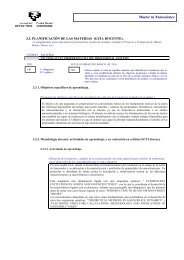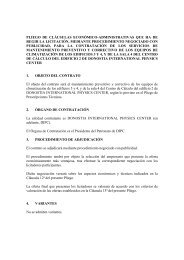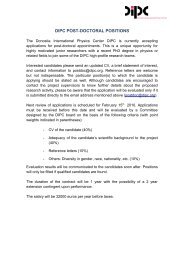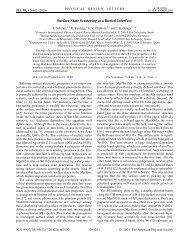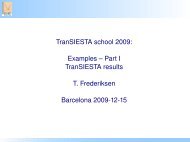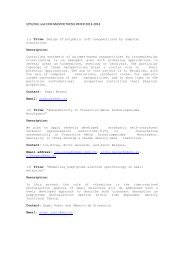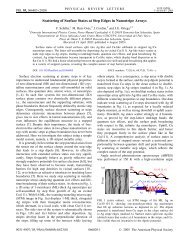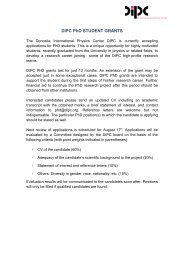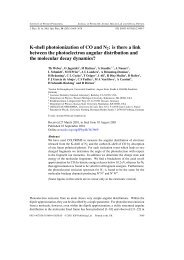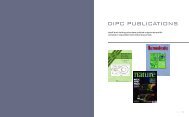Complete report - Donostia International Physics Center - Euskal ...
Complete report - Donostia International Physics Center - Euskal ...
Complete report - Donostia International Physics Center - Euskal ...
Create successful ePaper yourself
Turn your PDF publications into a flip-book with our unique Google optimized e-Paper software.
2010 DIPC Highlight<br />
Many-body effects in the excitation<br />
spectrum of a defect in SiC<br />
M. Bockstedte, A. Marini, O. Pankratov, and A. Rubio<br />
Physical Review Letters 105, 026401 (2010)<br />
Researchers from the <strong>Donostia</strong> <strong>International</strong> <strong>Physics</strong> <strong>Center</strong>, the <strong>Center</strong> of Materials <strong>Physics</strong><br />
(CISC) and the universities of Rome (Italy) and Erlangen-Nuremberg (Germany) demonstrated<br />
that the photophysics of the carbon vacancy in Silicon Carbide with two excitation channels involving<br />
conduction and valence bands is controlled by many-body effects beyond standard density<br />
functional theory through both the renormalization of the quasiparticle states and excitonic<br />
effects. Their analysis reassigns the excitation mechanism at the excitation thresholds observed<br />
in photoinduced paramagnetic resonance experiments.<br />
In their full fledge GW+BSE calculations of the photophysics of the carbon vacancy the authors demonstrated<br />
that experimental spectra cannot be interpreted correctly without the inclusion of many-body effects<br />
beyond the density functional theory. Excitation spectra are red shifted by strong excitonic effects<br />
(~0.23eV) and electron-electron repulsion is underestimated by 0.3eV. Among the two competing excitation<br />
channels only the transition of defect electrons to the conduction band has photon energies in the<br />
range compatible with the absorption thresholds observed in the experiments. The theoretical analysis<br />
unambiguously rectifies the earlier experimental assignment of the excitation mechanism and assessment<br />
of ionization levels. These are pivotal for the defect diffusion and for understanding the carrier compensation<br />
in high purity semi-insulating SiC.<br />
Optical spectra of solids are comprised of the excitations of the perfect crystal and of its omnipresent imperfections.<br />
For instance in transparent metal oxides small abundances of point defects absorb light in<br />
the visible range and thereby determine the color of the material. Defects recently came into focus as a<br />
promising implementation of quantum bits for the realization of solid state quantum computers. The quantum<br />
information stored in the defect spin state is read out via an optical excitation.<br />
Point defects as sources and sinks of charged carriers are fundamental for semiconductor technology<br />
without which modern world would not take place. In the investigation of novel materials for electronics,<br />
experiments unravel the role of specific defects via electronic and optical defect signatures. Unambiguous<br />
interpretation of the experiments and the assignment of microscopic defect models, however, requires<br />
theoretical support. Quantitative defect theory with density functional theory as its work horse successfully<br />
addressed the ground state defect physics and defect kinetics. Without being able to treat the excited<br />
state this work horse also notoriously underestimates semiconductor band gaps, thus, also affecting the<br />
prediction of defect level positions. Many-body perturbation theory is free from this error. The quantitative<br />
prediction of absorption spectra of a wide class of systems from insulators to surfaces, to nanotubes and<br />
polymers in this frame work became tractable only recently.<br />
The international research team of the <strong>Donostia</strong> <strong>International</strong> <strong>Physics</strong> <strong>Center</strong> and the <strong>Center</strong> for Materials<br />
<strong>Physics</strong> (CSIC), and Universities of Rome (Italy) and Erlangen-Nuremberg (Germany) addressed this problem<br />
for a prototypical defect within the frame work of many-body perturbation theory by solving the Bethe-<br />
Salpeter equation and accounting for the GW self-energy. They selected the carbon vacancy in silicon<br />
carbide for its well-established identification and the extensive experimental investigation of the excitation<br />
spectrum of the positively charged defect. For the accurate interpretation of the experiments at least two<br />
competing excitation channels are relevant: electron transitions from valence bands to localized defect<br />
levels as well as transitions of defect electrons to conduction bands. Defect excitations combine the manybody<br />
effects in both extended and localized states. Electron insertion into defect states invokes on-site<br />
correlation due to electron-electron repulsion (Hubbard U), and defect-to-band transitions involve an electron<br />
and a hole (one in the localized state and the other in the extended state), thus adding excitonic effects.<br />
Excitation channels of the positively charged carbon vacancy in SiC:<br />
(a) geometry with sketch of spin density of the paramagnetic electron.<br />
(b) defect levels within the band gap. In the ground state the a level is<br />
occupied with one electron. Arrows indicate transitions form valence<br />
bands (V→a/e, lower set) and to conduction bands (a→C, upper set).<br />
(c) sketch of the total energy of the positive (V + C ) and neutral (V 0 C ) vacancies<br />
vs. the atomic coordinates. The transition V→a transforms V+<br />
C<br />
into V 0 C with a bound hole in the valence band. The occupation of<br />
the defect level implies additional relaxation (Franck-Condon shift). (d)<br />
Absorption spectra with and without excitonic effects at the BSE and<br />
RPA level extrapolated to high k-point densities and including the effect<br />
of Franck-Condon shifts. The transitions to the conduction bands sets<br />
in at lower photon energies than the transitions from the valence bands.<br />
Excitonic red shifts and<br />
efect electron correlation<br />
are indispensible for<br />
unraveling the effect<br />
of competing defect<br />
excitation channels.<br />
46 DIPC 10/11<br />
DIPC 10/11 47



